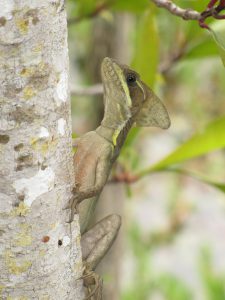
Florida has three times as many nonnative established lizards as native ones.
Among Florida’s approximately 50 species of nonnative lizards is the brown basilisk, a species now thriving in south and central Florida.
In a new peer-reviewed Extension document, scientists at the University of Florida Institute of Food and Agricultural Sciences (UF/IFAS) provide updated information for residents, property owners and land managers. They hope to engage the public in reporting sightings of the species. This will help scientists record how far and wide the brown basilisk continues to spread, while studying their behaviors, impacts and potential as an invasive species.
“There is still a lot we don’t know about the impacts of brown basilisks in south and central Florida,” said Ken Gioeli, a co-author and natural resources and environment agent at UF/IFAS Extension St. Lucie County. “We don’t know enough about their diet, reproduction or environmental impacts, but fortunately we have dedicated UF/IFAS research and Extension specialists studying these issues.”
While not all nonnative species evolve to become invasive, those that become established impact waterways, wildlife, agriculture and urban areas. This concerns scientists, wildlife organizations and communities.
Here are some highlights from the update.
The brown basilisk is within the family Corytophanidae, also known as the iguanian lizards. They go by several names such as helmeted or casque-headed lizards due to their head crests, a feature that distinguishes them from all other lizards. They are also known as “Jesus lizards” due to their ability to sprint across the surface of waters when fleeing predators.
A study published in Frontiers earlier this year by faculty at UF/IFAS Florida Medical Entomology finds that Culex mosquitoes prefer to feed on nonnative lizards. The brown basilisks are among five identified nonnative lizards that serve as hosts for the mosquitoes that can carry West Nile virus (WNV) and St. Louis encephalitis virus (SLEV) vectors in Florida.

Brown basilisks are brown or dark olive. They have a distinct yellow or cream-colored stripe on each side of their body that runs from the eye down their back. A second stripe is often visible on the face extending to the shoulder. They have long, thin tails and long rear toes. Adults can range in size from 11 to 27 inches.
First introduced to Florida through the pet trade, they were observed in the wild in 1963, according to the Florida Fish and Wildlife Conservation Commission. They have established rapidly, living outside their native range of Central America, surviving and producing populations.
As of February 2022, more than 160 specimens have been collected and recorded at the Florida Museum of Natural History Herpetology Collection database. The range of specimens found in coastal southeast and southwest counties stretches from Brevard to Monroe, with additional specimens from Manatee, Lee, Pinellas and Collier counties. The southern shore of Lake Okeechobee also has established populations.
Brown basilisks are active in the daytime year-round in Florida’s tropical weather. At night, they sleep on limbs and branches. Like most lizards, they feed on insects including grasshoppers, butterfly caterpillars and flies. Unlike most lizards, they will also prey upon spiders, crabs and even brown anole lizards and small snakes.
They are primarily found near fresh water, including canals, shorelines of lakes, retention ponds and ditches. They prefer areas with thick vegetation and are often seen basking and searching for insects on sidewalks, roads and parking lots.
“UF/IFAS plays a critical role, studying these nonnative species and teaching Floridians about the impacts they can have on our environment,” said Gioeli. “While we also have citizen scientists helping us spread unbiased research-based information and teaching the public through our Florida Master Naturalist, Florida Master Gardener Volunteer and 4-H Youth programs, residents can help by reporting sightings using EddMapS.”
###
By Lourdes Mederos, rodriguezl@ufl.edu
ABOUT UF/IFAS
The mission of the University of Florida Institute of Food and Agricultural Sciences (UF/IFAS) is to develop knowledge relevant to agricultural, human and natural resources and to make that knowledge available to sustain and enhance the quality of human life. With more than a dozen research facilities, 67 county Extension offices, and award-winning students and faculty in the UF College of Agricultural and Life Sciences, UF/IFAS brings science-based solutions to the state’s agricultural and natural resources industries, and all Florida residents.
 1
1
